
The Dry Dredgers returned to their annual trek to a popular byway on the Kentucky side of the Ohio River that we enjoy cruising from road cut to road cut. The sites expose the Kope Formation (Edenian Stage formations) and the Fairview Formation. These formations expose rocks and fossils that are about 450 million years old.
We met and gathered at a nearby parking lot so that we could caravan from site to site.
Latecomers would have to drive down the highway looking for the long row of
parked cars and a sign announcing are presence.
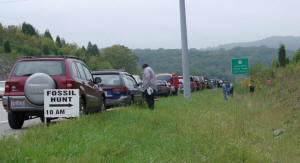
Here are some photos of the site at our first stop. Bill Heimbrock provided a
handout documenting the layers according to accepted professional papers and
field guides.
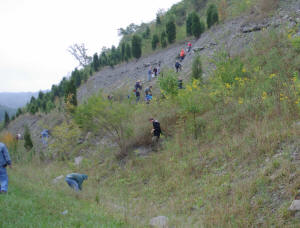




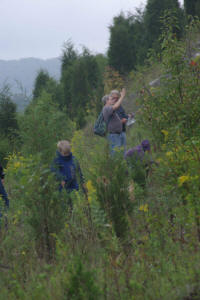

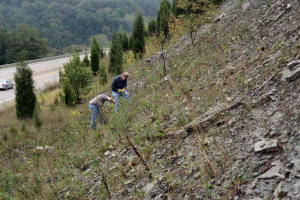
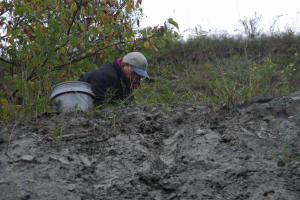


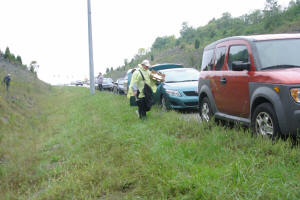
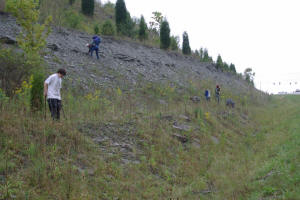
Second Site
As you can see from the photo below, we had a very long
caravan of cars going from the first site to the second. Rain threatened but we
didn't see much precip.
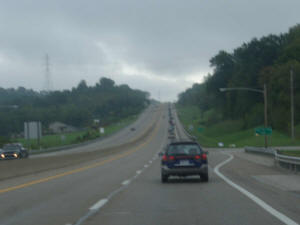
The second site was slightly higher up in the strata, but
basically the same mix of fossils.
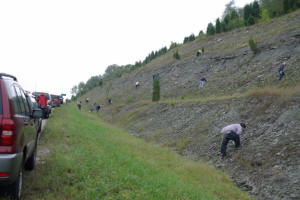
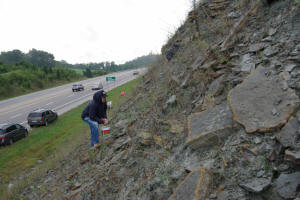
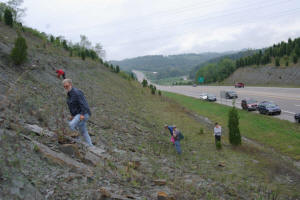
Fossils Found That Day
Crinoids
As usual, some of the best finds of the day were crinoids.
The Kope formation in particular is loaded with them. This first picture is of a
beautiful calyx (cup or head) of the crinoid
Ectenocrinus simplex.

This next picture is of a crinoid stem that
terminates in mass that looks like a break in the stem that healed.
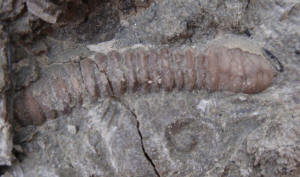
Here's a really nice stem that has been
pieced together. It is
probably from the large crinoid
Anomalocrinus.

Anomalocrinus has a holdfast that is often
volcano shaped. (next two pics)
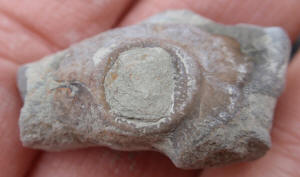

This is a fragment of a crinoid calyx.
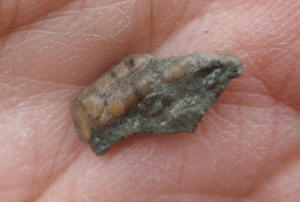
Lots of articulated stems were found in the surface of rocks.

Straight-shelled Nautiloid Cephalopods
Here's a straight-shelled Nautiloid Cephalopod with some nice
brown coloring and preservation of the chambers of the mollusk's shell. The
chambers seem slightly angled. In some cases, that indicates the shell is part
of the siphuncle. In this case, I think it's just the way the shell was
preserved.
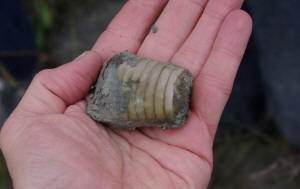
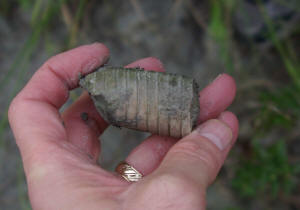
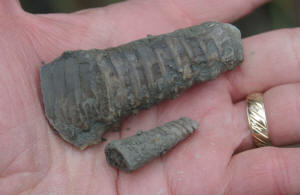



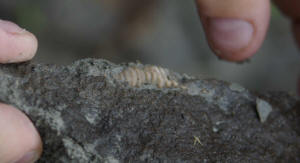
This same nice shell preservation was found all along the
highway. Here are some of the nice specimens found by Brenda Gartz. Thanks for
the photos, Brenda. (next four pictures)
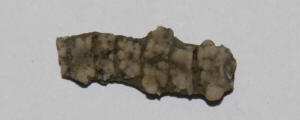


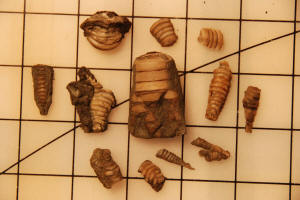
Bryozoans
also encrusted some of these Cephalopods. These next two pictures show the
encrusting bryozoan, Spatiopora.
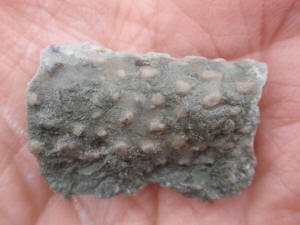

Bryozoans
One
of the few bryozoans that can be identified to
the genera without thin sectioning is Constellaria, which have
distinct monticules in the shape of stars.
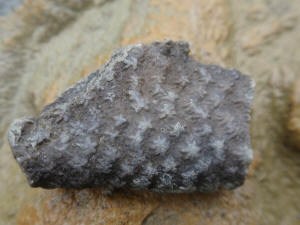
Bryozoans in the Cincinnatian are often categorized by their shape. Here are some pictures of the ramose (branching) bryozoans we saw.
Another shape for the bryozoan we saw is "leafy."
Yet
another shape we saw are bryozoans that encrust objects and the hard parts of
other animals. Here is a very interesting specimen of a bryozoan that has
encrusted a crinoid stem and continued to grow around the stem.
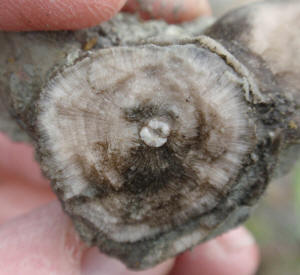
Trilobites
Yes,
whole trilobites were found. They were enrolled specimens of the common
Cincinnatian, Flexicalymene. The species is probably granulosa, which is most
common in the Kope formations.
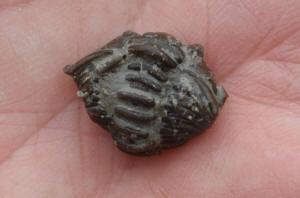
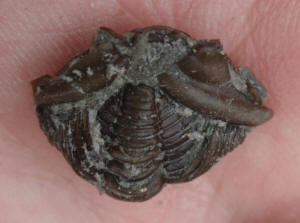
We
found parts of the very large trilobite Isotelus. These next three photos show
fragments of the genal spine and thorax segments.

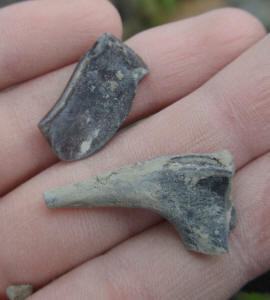

The above Isotelus fragments were seen on the surface of a slab.
Trace Fossils (Ichnofossils)
One of the many interesting
trace fossils we saw was this example of Catellocaula vallata,
which left star shaped holes in bryozoans.

In
the layers that expose the Fairview Formation, we found numerous examples of a
trace fossil that I'm not sure what made these burrows. The shale you see in
these photos are casts of of the burrows.
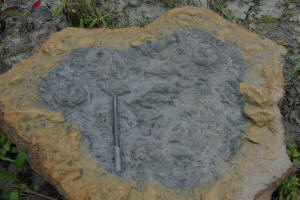

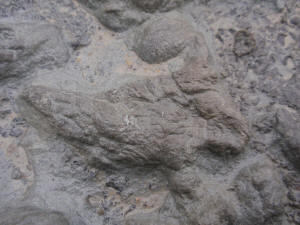
A
common and easy to identify trace fossil is Diplocraterian.
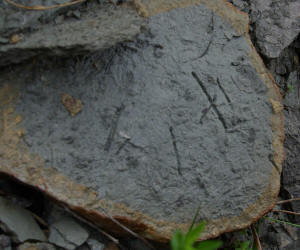
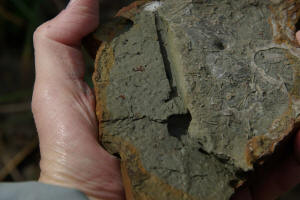
Now
here's something that can be mistaken for an ichnofossil. It is the well
documented millimeter-sized ripple marks that are common in a layer of the
Southgate.
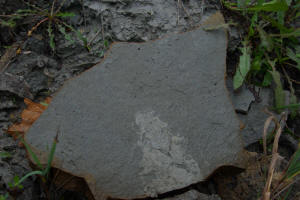
Gastropods (snails)
We found a lot of spired gastropods.
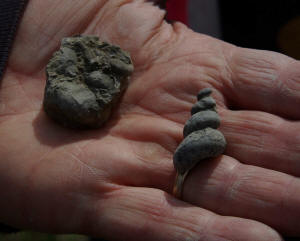
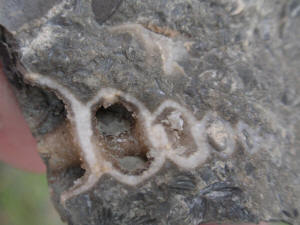

Brachiopods
Brachiopods found include Rafinesquina, Zygospira, Cincinnetina, Sowerbyella and Vinlandostrophia.
Here's
a shot showing a Zygospira, a crinoid
stem and a Cincinnetina (left right).
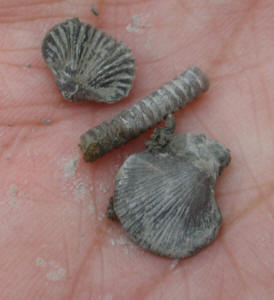
Slabs
covered with Cincinnetina serve as marker beds to delineate
formations and formation members.
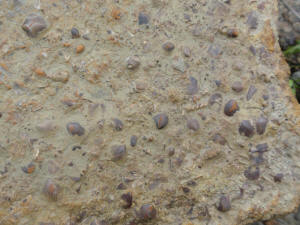
Storm
events were preserved in rock layers. Here's a slab full of "shingled"
Rafinesquina, that show the devastation
of a violent storm.

Impressions
Hard parts of animals often left impressions on the surface of
rocks. Sometimes these were internal or external molds. This next photo appears
to be of internal molds of snails and clams. The photo after that is an external
mold, perhaps of a monoplacophoran.
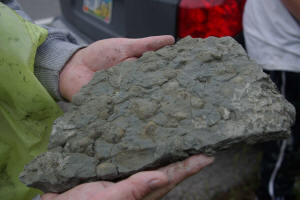
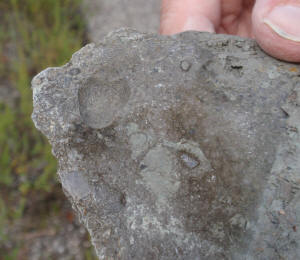
That's all for this trip. We hope you enjoyed it.
Now let's take a look at our October 2011 Field Trip.
To see our previous trips to this scenic byway...
October 2010
October 2008
March 2007
October 2005
October
2002
Return to Index of Field Trips
Return to Dry Dredgers Home Page
The Dry Dredgers and individual contributors reserve the rights to all information, images, and content presented here. Permission to reproduce in any fashion, must be requested in writing to admin@drydredgers.org .